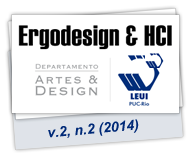Transparência e imersão em uma interface de videogame: análise com base semiótica
DOI:
https://doi.org/10.22570/ergodesignhci.v2i2.28Resumo
RESUMO
Neste artigo serão demonstrados alguns aspectos da teoria semiótica aplicados na análise dos elementos da interface gráfica de um videogame. inicialmente serão definidos os conceitos e terminologia empregados na contextualização do exercício de análise. esta primeira parte tem como foco a apresentação da problemática envolvendo a relação entre a transparência de uma interface gráfica e o nível de imersão a que se submete o jogador. Em seguida, será apresentado o método escolhido para a realização da análise que seguirá um percurso de aplicação proposto por Santaella (2002) com base na teoria do signo de Peirce, e envolve a descrição formal de cada signo e interpretação geral do contexto.
como objeto de análise, será utilizado o head-up display do jogo dead space. as considerações finais destacam um forte apelo aos elementos diegéticos, que podem contribuir com a construção de um ambiente de jogo sólido e gerar uma experiência mais imersível.

Videogame, Imersão, Semiótica
TITLE: Transparency and soak in a vídeo game interface: analysis based semiotics
ABSTRACT
1 Context
This article demonstrates some aspects of semiotic theory applied at the analysis of the graphical user interface elements of a video game. Initially the concepts and terminology used in the context of the analyzed object it will be defined. this first part focuses on the introduction of the problematic that involves the relation between the transparency of a graphic user interface and the level of immersion achieved by the player. Then, the method of choice for the analysis exercise, which follows an application path proposed by Santaella (2002) which is based on Peirce’s sign theory, will be presented. That method involves a formal description of each sign and a general contextual interpretation. The object chosen for this analysis is the head-up display from the video game dead space. as closing comments, a strong appeal to the diegetic elements is highlighted, which can contribute to build a solid game environment and generate a more immersive experience.
2 Method
Aiming to demonstrate the application of some concepts of Peirce's semiotic theory, will be presented an analysis of the process of signification and interpretation of the elements of an interface graphics of a video game. The present study It is characterized as part of the output from a more comprehensive project, which studies the influence transparency of video game interfaces in sense of player immersion. The analysis semiotics, in that project, plays the role to structure the description of the repertoire of each sampling interface, thus obtaining a panorama of the communicative potential of the same. Why be a fragment removed from his unique panorama, is incurred on the need toa brief presentation of the context in which it was semiotic analysis developed here documented. Thus, the presented content It follows a progression which, initially, will be defined the concepts of "transparency" and "Immersion": the first presented based on point of view of three authors; and the second, related general definitions of the concept and as well as the ways used by videogames to generate a feeling deep en-gagement. This concept will be associated also with the theory of flow, which it de-scribes the immersion from the perspective of psychology.
The presentation of the terminology of the video game interfaces, used throughout the remainder of the text, follows this first step. The method used for the analysis of exercise is presented in item 3 and follows a route application based on the propositions of Santaella (2002). Then focuses on the process description and analysis of the subject matter, the game Dead Space, launched in 2008 and available for multiple platforms consoles and computers. The analysis sought to reference the concepts and established relationships addressed in the semiotic theory structuring the process, thereby producing material for the process of reflection on how the Transparency can help with the feeling soaking through the process of signification. At the end of this study is a brief discussion focused on the goal of the project which the content of this article is part addressing the relationship between transparency and dipping, as well an assessment of the role of analysis meaning this type of study.
3 Results
Integration and contextualization are concepts that, when properly used in the organization of information , allow the media to immerse the message and acting work itself as media. HUDs , to immerse themselves in the reality of the game itself , can carry the player and this , in turn , in the midst of a process of more intensive decoding, is induced to a deeper involvement. The player , in addition to not be perceived more as an intermediary in the process, have your senses overwhelmed by stimuli only from the gaming experience , not leaving much cognitive ability to process the outside world. Thus obtaining transparency in video games may depend largely on the success achieved by replacing messages commonly conveyed by HUDs , notorious as this element on an external level , by broadcast messages or stimuli in an integrated way to the mechanics of the game it-self. 4.Conclusions Translating into concepts borrowed from storytelling , or construction of narratives , the game , when using interfaces integrated into its universe , make the role of the " narrator " and goes on for role play or act. The HUD starts to talk directly with the character of the game, putting the player almost like a hidden spectator of such information, although this continue to participate actively and intensively the experience. Thus, with the transparency of the HUD and intermediation , the player , as an external interpreter , it is also transparent.

Videogame, Immersion, Semiotics
Downloads
Publicado
Edição
Seção
Licença
Copyright (c) 2016 Revista Ergodesign & HCI

Este trabalho está licenciado sob uma licença Creative Commons Attribution 4.0 International License.




